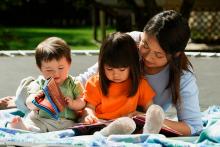Pediatricians, parents, and teachers should prioritize play for children under their care because of its significant benefits, such as encouraging learning, building social bonds, and regulating stress, according to a clinical report from the American Academy of Pediatrics.
“We’re recommending that doctors write a prescription for play because it’s so important,” Michael Yogman, MD, of the department of pediatrics at Harvard Medical School, Boston, and Mount Auburn Hospital in Cambridge, Mass., said in a press release.
“Play with parents and peers is fundamentally important for developing a suite of 21st century skills, including social, emotional, language, and cognitive skills, all needed by the next generation in an economically competitive world that requires collaboration and innovation,” he continued. “The benefits of play cannot really be overstated in terms of mitigating stress, improving academic skills, and helping to build the safe, stable, and nurturing relationships that buffer against toxic stress and build social-emotional resilience.”
The report, published in the journal Pediatrics, is an update to a 2007 report that adds new research about the importance of play for children even as society has shifted its focus to “academic readiness” rather than “playful learning.” In the report, the authors cited the numerous benefits of active play for both children and adults. They noted a study of children who were aged 3-4 years that showed a twofold decrease in their anxiety after playing with toys or with their peers for 15 minutes, compared with listening to a teacher read a story. In another study, preschool children who played with blocks at home with minimal adult supervision and guidance had better language acquisition skills after 6 months. Results from studies also have shown that children who had 1 hour each day of active playtime had better creative and multitasking skills. For adults, the authors said playtime is an opportunity for them to “reawaken the joy of childhood and rejuvenate themselves,” as well as a chance to bond and become more effective communicators with their children.
However, Dr. Yogman and his associates noted there are many modern barriers to play. They cited how overscheduling of enrichment programs leaves little time for free play, an increased focus on academic achievement and test scores, the ways that economically challenged families may have less time to play with their children, and safety concerns about playing outdoors as some of the reasons for a decrease in active play among children. Between 1981 and 1997, there was a 25% decrease in the number of children who went outdoors to play once per day, and there is now a 30% decrease in kindergarten children who have access to recess because of an increased focus on academics, they wrote. In addition, the average child of preschool age spends 4.5 hours each day watching television.
“Media use, such as television, video games, smartphone, and tablet apps, [is] increasingly distracting children from play. It’s concerning when immersion in electronic media takes away time for real play, either outdoors or indoors,” Jeffrey Hutchinson, MD, a study coauthor, said in a press release.
“Although active engagement with age-appropriate media can be beneficial for older children, especially if supported by co-watching or co-play with peers or parents, real time social interactions and play are superior to digital media for learning,” said Dr. Hutchinson of the Uniformed Services University, Bethesda, Md.
The AAP made the following recommendations, among many others, to parents, pediatricians, and teachers for encouraging play in children aged 6 years and younger:


